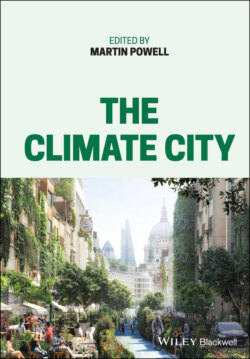Читать книгу The Climate City - Группа авторов - Страница 33
Notes
Оглавление1 1 UN DESA: 2018 Revision of World Urbanization Prospects. https://www.un.org/development/desa/en/news/population/2018-revision-of-world-urbanization-prospects.html.
2 2 UN estimates > 60% of GHGs and consuming 78% of global energy; C40 estimates > 70% of GHGs, consuming two-thirds of global energy. https://www.un.org/en/climatechange/climate-solutions/cities-pollution. https://www.c40.org.
3 3 Boyd, P., Pickett, C.R., 2020. Defining Net-Zero: Addressing climate change requires a clear, bold explanation of our shared global goal. Yale Center for Business and the Environment. https://cbey.yale.edu/research/defining-net-zero.
4 4 Global Protocol for Community-Scale Greenhouse Gas Emission Inventories. https://ghgprotocol.org/sites/default/files/standards_supporting/gpc_executive_summary_1.pdf.
5 5 By “destination-based” we mean to distinguish an absolute target from a relative one. Many climate targets are relative, for example, “80% less emissions than our 1990 baseline”. Relative targets do not tell a reader if their achievement is consistent with a world in carbon balance. Destination-based targets do.
6 6 Science-based targets have historically focused on corporate action, but the Science-Based Targets Network has more recently started to “translate the science that defines the limits of nature … into actionable targets for cities. https://sciencebasedtargetsnetwork.org/earth-systems.
7 7 Our Common Future. https://sustainabledevelopment.un.org/content/documents/5987our-common-future.pdf. In Commissioner Brundtland’s own foreword: “the ‘environment’ is where we all live; and ‘development’ is what we all do in attempting to improve our lot within that abode. The two are inseparable”.
8 8 In the lead-up to the next global climate talks in Glasgow, the UN champions of the “Race To Zero” campaign are calling for net-zero targets “in the 2040s”.
9 9 UNFCCC, 2015. Paris Agreement. 3–4. https://unfccc.int/sites/default/files/english_paris_agreement.pdf (accessed 3 June 2020).
10 10 Rogelj, J., Luderer, G., Pietzcker, R., et al., 2015. Energy system transformations for limiting end-of-century warming to below 1.5°C. Nature Climate Change 5, 519–527. https://www.nature.com/articles/nclimate2572.
11 11 Masson-Delmotte, V., Zhai, P., Pörtner, H.O., et al. (eds), 2018. Global warming of 1.5°C. An IPCC Special Report on the impacts of global warming of 1.5°C above pre-industrial levels and related global greenhouse gas emission pathways, in the context of strengthening the global response to the threat of climate change, sustainable development, and efforts to eradicate poverty. https://www.ipcc.ch/sr15.
12 12 US Global Change Research Program, 2018. Fourth National Climate Assessment. Vol. II. https://nca2018.globalchange.gov/downloads.
13 13 Ripple, W.J., Wolf, C., Newsome, T.M., Barnard, P., Moomaw, W.R., 2020. World scientists’ warning of a climate emergency. BioScience 70(1) January, 8–12. https://academic.oup.com/bioscience/advance-article/doi/10.1093/biosci/biz088/5610806.
14 14 C40: Deadline 2020. https://www.c40.org.
15 15 UNFCCC, 2021. Who’s in Race to Zero? https://unfccc.int/climate-action/race-to-zero/who-s-in-race-to-zero#eq-4.
16 16 C40: Consumption-Based GHG Emissions of C40 cities. https://www.c40.org/researches/consumption-based-emissions.
17 17 US EPA, n.d. Greenhouse gases at EPA. https://www.epa.gov/greeningepa/greenhouse-gases-epa (accessed 3 June 2020).
18 18 C40. Op. cit., p. 15.
19 19 Greenhouse gases are “any gas that has the property of absorbing infrared radiation (net heat energy) emitted from Earth’s surface and reradiating it back to Earth’s surface, thus contributing to the greenhouse effect. Carbon dioxide, methane and water vapor are the most important greenhouse gases. (To a lesser extent, surface-level ozone, nitrous oxides, and fluorinated gases also trap infrared radiation.)” Encyclopaedia Britannica, n.d. Greenhouse gas. https://www.britannica.com/science/greenhouse-gas (accessed 3 June 2020).
20 20 McKinsey Quarterly, 2020. Climate math: What a 1.5-degree pathway would take. https://www.mckinsey.com/business-functions/sustainability/our-insights/climate-math-what-a-1-point-5-degree-pathway-would-take.
21 21 Science Based Targets, n.d. What are “science based targets”? https://sciencebasedtargets.org/what-is-a-science-based-target (accessed 3 June 2020).
22 22 City Finance Approach to Climate-Stabilising Targets, 2018. https://www.autodesk.co.uk/sustainability/business-operations/cfact-cities.
23 23 https://resourcecentre.c40.org/climate-action-planning-framework-home.
24 24 https://www.london.gov.uk/sites/default/files/1.5_action_plan_amended.pdf.
25 25 Disclosure – The author is a Senior Advisor to, and supporter of, REDD.plus.
26 26 McKinsey Quarterly, 2020. Op. cit., pp. 9–11.
27 27 Microsoft, 2020. Microsoft will be carbon negative by 2030. https://blogs.microsoft.com/blog/2020/01/16/microsoft-will-be-carbon-negative-by-2030 (accessed 3 June 2020).
28 28 Sourcing analysis for scalability of abatement solutions (McKinsey Global Institute, Global Carbon Budget 2015, Coalition for Rainforest Nations). The top three sectoral abatement opportunities are Forests & Agriculture (estimated 10–12 Gt pa). Power at 10 Gt pa and Industry at 8 Gt pa.
29 29 Sustainability – Operation Cat Drop. https://www.youtube.com/watch?v=17BP9n6g1F0v=.
30 30 Argyris, C., 1990. Overcoming Organizational Defenses: Facilitating Organizational Learning. Pearson, New York.
31 31 https://waterscenterst.org.
32 32 Meadows, D., 1999. Leverage Points: Places to Intervene in a System. Sustainability Institute, Hartland, VT.
